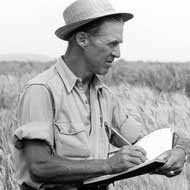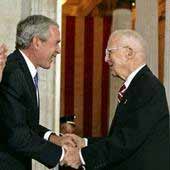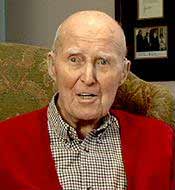VOICE ONE:
This is SCIENCE IN THE NEWS in VOA Special English. I'm Barbara Klein.
VOICE TWO:
And I'm Doug Johnson. Today we tell about the American plant scientist Norman Borlaug. He won the Nobel Peace Prize for his efforts to increase food production around the world. His work to battle world hunger is credited with saving millions of people from starvation.
(MUSIC)

VOICE ONE:
Norman Borlaug traveled the world to help people develop better ways to produce food. This might explain why he is probably better known overseas than in the United States.
Borlaug worked in fields to show farmers new ways to grow crops like wheat and rice. He also worked in the laboratory to create new versions of wheat that could resist disease.
Borlaug became known as the "Father of the Green Revolution." Some people say he saved more lives than anyone else in history. Yet one American newspaper says he described himself simply as a "corn-fed, country-bred Iowa boy."
VOICE TWO:
Norman Ernest Borlaug was born to Norwegian-American parents in rural Iowa on March 25th, 1914. He grew up on a farm. He began his education in a one-room country schoolhouse.
Family members say young Norman was interested in plants. They say he often asked why some plants grew better in different areas of the farm.
Norman's family urged him to continue his studies at a time when many farm boys left school to find a job. He later worked on farms, earning 50 cents a day to pay for college during the Great Depression.
(MUSIC)
VOICE ONE:
Borlaug attended the University of Minnesota, where he completed a study program in forestry. During the Depression, he witnessed people going hungry in the central United States. This deeply influenced his interest in agricultural sciences and better ways to produce food.
As a young man, Borlaug worked for a short time on forestry projects in Idaho and Massachusetts. He later returned to the University of Minnesota to study plant pathology. After those studies were completed, he worked as a researcher at a laboratory owned by the DuPont chemical company.
VOICE TWO:
During this period, many experts warned of mass starvation in the developing world where populations were expanding faster than crop production.
In 1944, Borlaug left his job with DuPont, and began a project to increase Mexico's wheat production. He became the head of the newly-formed Cooperative Wheat Research and Production Program in Mexico. The program received financial support from a private group, the Rockefeller Foundation.
(MUSIC)
VOICE ONE:
The farming conditions Borlaug found in Mexico were extremely bad. The soil was not good for growing crops, and disease was destroying the plants. Over the next 20 years, Borlaug worked with Mexican scientists to develop crops that were able to resist disease. This was done by crossbreeding different kinds of wheat to make stronger, more resistant ones. He and the scientists also developed plants that produced higher quantities of grain.
Borlaug worked with wheat genes to shrink the plant while keeping the grain large. Using the same amount of land, the new wheat variety could produce three to four times as much food. This method of shrinking plants would become a major part of the Green Revolution.
Mexico imported 60 percent of its wheat in the early 1940s. By 1956, the country produced enough wheat to feed its population. By 1963, Mexico began exporting wheat.
VOICE TWO:
Working with researchers throughout the world, Borlaug began to offer his methods in areas where people were threatened with starvation. He began to receive urgent requests from poor countries where population growth was more than the food supply could feed.
Borlaug's first stop was Asia. He and his team had great success in Pakistan and India. Local farmers could grow four times more wheat than before. Pakistan was able to feed its own population by 1968. Six years later, India also became self-sufficient. Borlaug also brought his methods to the Middle East and South American countries like Brazil, Chile, Colombia and Ecuador.
(MUSIC)
VOICE ONE:
In 1970, Borlaug won the Nobel Peace Prize for his efforts toward world peace through increasing food supply. At the time of the announcement, Borlaug was working in farmland in Mexico.
When he heard the news, he thought it was a joke. It is said that he traveled the 80 kilometers to Mexico City to meet with reporters and arrived with dirt on his hands. Later that year, Borlaug traveled to the home of his ancestors, Norway, where he received the Nobel Peace Prize.

Borlaug also won the highest civilian honors in the United States. He was given the Presidential Medal of Freedom in 1977. 30 years later, he received the Congressional Gold Medal.
Borlaug is one of only five people to receive all three honors. The others are Martin Luther King Junior, Nelson Mandela, Mother Teresa and Elie Wiesel.
VOICE TWO:
One of the lasting effects of Norman Borlaug is the World Food Prize, which he established in 1986. The award recognizes the work of individuals who have helped human development by improving the quality, quantity or availability of food in the world.
Shortly after Borlaug's death, billionaire Bill Gates spoke at the World Food Prize symposium in Iowa.
BILL GATES: "In the middle of the 20th century, experts predicted famine and starvation. But they turned out to be wrong, because they did not predict Norman Borlaug. He not only showed humanity how to get more food from the Earth, he proved that farming has the power to lift up the lives of the poor."
VOICE ONE:
Norman Borlaug's work lives on through the Borlaug Fellowship Program. The Department of Agriculture supervises the program. It brings foreign agricultural scientists to the United States each year and places them with American scientists.
Later in his life, Borlaug turned his attention to Africa. He and former American President Jimmy Carter worked with the Sasakawa Africa Association to help increase the quality and production of corn on the continent.

VOICE TWO:
But not everyone considered Borlaug a hero. Environmental activists criticized his intensive methods, including use of fertilizers and pesticides. These products are used to help plants grow and protect them from insects.
Borlaug suggested that Western critics had never known real hunger. He also wondered if they had ever watched their children go hungry.
Borlaug's desire to feed the world is what drove him. He was a firm believer that the job of feeding the world could not be done without fertilizers and pesticides. Borlaug and those who followed his lead argued that older methods of sustainable farming could not produce enough food to prevent hunger in poorer areas of the world.
In 1971, he criticized opponents of the insecticide DDT, which was later banned in the United States.
NORMAN BORLAUG:"I am very proud to be an American but I am also frightened by this hysteria. [If we] remove DDT the next will be all insecticides, after that it will be all the weed-killers and the fungicides and then the fertilizers, if the hysteria prevails. And when this happens, sir, the U.S. will be importing food, only there won't be any place from where to import it."
VOICE TWO:
But later in life, Borlaug urged farmers not to overuse chemical products.
VOICE ONE:
Up until his death in September 2009, Borlaug was still working on agricultural projects. He was a professor of international agriculture at Texas A and M University in Texas. The university established an institute in his name.
Six months before his death, Norman Borlaug spoke to VOA at his 95th birthday party. Borlaug said he was worried about the world's ability to feed itself. He said that the work to improve crop production must continue.
Borlaug suffered from lymphoma. Health problems linked to the disease led to his death. Borlaug's family released a statement shortly after he died. It said they wanted his life to be an example for making a difference in the lives of others, and for working toward the goal of ending suffering for all mankind.
(MUSIC)
VOICE TWO:
Our program was written and produced by Brianna Blake. I'm Doug Johnson.
VOICE ONE: And I'm Barbara Klein. You can download this program and others from our Web site, voaspecialenglish.com. Join us again next week for more news about science in VOA Special English.
lymphoma: any of various usually malignant tumors that arise in the lymph nodes or in other lymphoid tissue 淋巴瘤
Related stories:
Remembering Norman Borlaug
Green Revolution hero Norman Borlaug dies at 95
Food crisis could push millions of people into poverty
Fighting a food crisis
(Source: VOA 英語點津編輯)